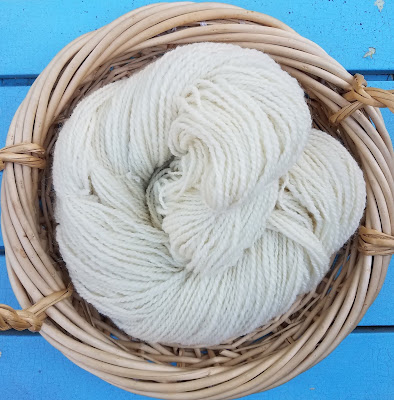Longtime readers may remember that I did the Sheepspot Fiber Club / Breed School back in 2015-2016ish. The first incarnation involved breed-specific, dyed fiber, delivered every other month. I learned a lot during that time but only stayed in the club for 2 years, as I had some other spinning experiences lined up.
I couldn't resist re-joining when Sasha re-conceived the club as Breed School 2.0 earlier this year. In the current version, you still get breed-specific fiber on the regular, but you get it every month. Unlike before, the fiber is undyed (but not always white, because not all sheep are white). Also, the amount of fiber delivered is 150 grams rather than the more typical 100-gram bump. The extra fiber is included to encourage the development of a sampling habit. Sasha includes instructional videos every month showing how she samples that month's breed.
The first fiber (shipped in mid-August) was Targhee, a finewool breed. I've spun Targhee before and enjoyed it again. However, being a fairly obedient student, I completed samples before deciding how to spin the bulk of the fiber. Here they are, all laid out nicely:
When sampling, I usually tear off about 5 grams of fiber for each sample. It doesn't take long to spin, and I make a 2-ply sample from a plying bracelet. These are the techniques we typically try: short forward draft, short forward draft allowing twist in the drafting zone, from the fold, from the fold supported long draw, and long draw from rolags. These 5 techniques represent a spectrum from the most worsted technique to the most woolen technique.For the Targhee (which was prepared as combed top), I chose a classic worsted yarn: short forward draft. I spun the singles pretty fine and made a 3-ply yarn that is about 12 WPI (wraps per inch), which I figure it roughly a DK weight yarn. It is so poofy and soft. This will make something wonderful to wear around a neck. I was really happy with this skein!
Technically, Targhee was the July fiber. Shipments go out on the 15th of each month, so I worked on that from July into August.
The August fiber was Gotland, a modern Swedish breed developed in the early 20th century. In The Fleece & Fiber Sourcebook, Deb Robson classifies Gotland in the "Northern-European Short-Tailed Family," which is to say, it's not neatly categorized into the usual groups of fine wools, medium wools, and long wools. I loved the beautiful, variegated gray colors in this top. And when I opened the ziploc bag, a wonderful sheepy smell emerged and made me think I was at the Maryland Sheep & Wool Festival. That first whiff was divine!
I ended up spinning it from the fold, long draw, at 12.5:1 with much-slower-than-typical treadling. I made a 2-ply yarn that is 12 WPI (DK-ish). I got 248 yards and my skein weighs 125 g.
This is a strong yarn that is probably not destined to become clothing. Maybe I could use it on something like this Yan Tan Tether pillow (although that pattern calls for fingering and my yarn isn’t as fine). But something like it?
The September fiber was Whitefaced Woodland, which is a conservation breed from England which Deb Robson puts in a category titled "Other." She writes that fleeces are inconsistent, so each one needs to be judged separately. Some are fine and some are not, and staple length can vary from 3-8". The top I received had staple length of about 5", right in the middle of the range.
I did my usual sampling. My favorites were #1 (SFD - short forward draft) and #4 (LD FTF - long draw, from the fold). I liked the look of #2, but it kind of hurt my left thumb, so I didn't want to commit to a longer project with that technique. And the rolags were a mess - 5" fiber is too long for carding into rolags!
I ended up spinning this longdraw, from the fold. The yarn is more varied than I expected (I guess I need to keep working on consistency) but will be lovely when knit or woven. My 2-ply skein averages out to 10 WPI, or worsted weight, and measures about 268 yards.
Whitefaced Woodland was one of the breeds I got from Sasha's earlier club some years ago. I ended up using some of that yarn to make a pair of fingerless mitts. I think handwear is a good use for this breed, and I also think the yarn I just made is better than the yarn I made some years ago (which was a little overtwisted and wiry). It's gratifying to see the difference.
I am enjoying most aspects of this club/breed study. The one thing I am missing is COLOR. I know some people spin natural colors almost exclusively, but I really want other colors... and I'm not a dyer. I need to think about that. Do I want to learn some basic dying techniques? Or are these skeins "just" for learning? Hmmm...














No comments:
Post a Comment